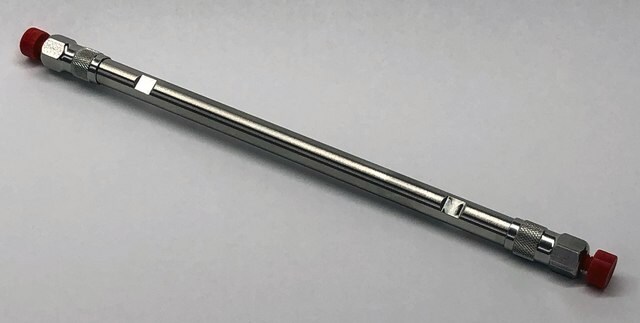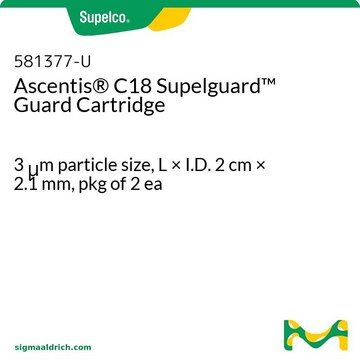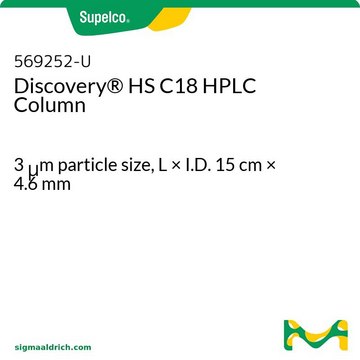Kluczowe dokumenty
581301-U
Ascentis® C18 (3 µm) HPLC Columns
L × I.D. 10 cm × 2.1 mm, HPLC Column
Synonim(y):
Ascentis RP18 HPLC Column
About This Item
Polecane produkty
product name
Ascentis® C18 HPLC Column, 3 μm particle size, L × I.D. 10 cm × 2.1 mm
Materiały
stainless steel column
Poziom jakości
agency
suitable for USP L1 (Similar to Phenomenex Luna C18)
linia produktu
Ascentis®
Właściwości
endcapped
producent / nazwa handlowa
Ascentis®
opakowanie
1 ea of
zakres etykietowania
25% Carbon loading
Parametry
≤70 °C temp. range
400 bar pressure (5801 psi)
metody
HPLC: suitable
LC/MS: suitable
dł. × śr. wewn.
10 cm × 2.1 mm
powierzchnia
450 m2/g
pokrycie powierzchni
3.7 μmol/m2
zanieczyszczenia
<5 ppm metals
macierz
fully porous particle
silica gel high purity, spherical
grupa aktywna macierzy
C18 (octadecyl) phase
wielkość cząstki
3 μm
wielkość porów
100 Å
operating pH range
2-8
Zastosowanie
food and beverages
metoda separacji
reversed phase
Szukasz podobnych produktów? Odwiedź Przewodnik dotyczący porównywania produktów
Powiązane kategorie
Opis ogólny
Ascentis C18 is an extremely stable and reliable first choice HPLC column that gives symmetric peak shape and excellent retention even for difficult compounds.
Zastosowanie
- Identification of recombinant human insulin and biosynthetic insulin analogues by multiplexed targeted unlabeled mass spectrometry of proteotypic tryptic peptides.: This study employs the Ascentis® C18 HPLC column for the separation of proteotypic tryptic peptides, allowing the identification of human insulin and biosynthetic insulin analogues through multiplexed targeted unlabeled mass spectrometry. The method demonstrated high specificity and sensitivity, enhancing the accuracy of insulin analysis in pharmaceutical research (Qasem et al., 2019).
- Development and validation of a novel stability-indicating HPLC method for the simultaneous assay of betamethasone-17-valerate, fusidic acid, potassium sorbate, methylparaben, and propylparaben in a topical cream preparation.: Utilizing the Ascentis® C18 HPLC column, this research presents a novel stability-indicating method for the simultaneous assay of multiple compounds in a topical cream. The validated method offers robust stability assessment, critical for ensuring the quality and efficacy of pharmaceutical formulations (Byrne et al., 2014).
- HPLC-DAD and HPLC-ESI-MS/MS methods for metabolite profiling of propolis extracts.: This paper describes the use of the Ascentis® C18 HPLC column in HPLC-DAD and HPLC-ESI-MS/MS methods to profile metabolites in propolis extracts. The column′s performance in separating complex mixtures highlights its utility in natural product research and quality control (Pellati et al., 2011).
- Practical comparison of 2.7 microm fused-core silica particles and porous sub-2 microm particles for fast separations in pharmaceutical process development.: This study compares the performance of the Ascentis® C18 HPLC column with other chromatographic columns for fast separations in pharmaceutical process development. The Ascentis® column provided superior separation efficiency and speed, making it advantageous for high-throughput pharmaceutical analysis (Abrahim et al., 2010).
Cechy i korzyści
- Excellent retention
- Symmetric peak shape
- High reproducibility
- Complete LC-MS compatibility
Informacje prawne
Nie możesz znaleźć właściwego produktu?
Wypróbuj nasz Narzędzie selektora produktów.
Zastosowanie
kartridż do prekolumny
Kod klasy składowania
11 - Combustible Solids
Klasa zagrożenia wodnego (WGK)
WGK 3
Temperatura zapłonu (°F)
Not applicable
Temperatura zapłonu (°C)
Not applicable
Wybierz jedną z najnowszych wersji:
Masz już ten produkt?
Dokumenty związane z niedawno zakupionymi produktami zostały zamieszczone w Bibliotece dokumentów.
Chromatograms
application for SPE, application for LC-MSNasz zespół naukowców ma doświadczenie we wszystkich obszarach badań, w tym w naukach przyrodniczych, materiałoznawstwie, syntezie chemicznej, chromatografii, analityce i wielu innych dziedzinach.
Skontaktuj się z zespołem ds. pomocy technicznej







